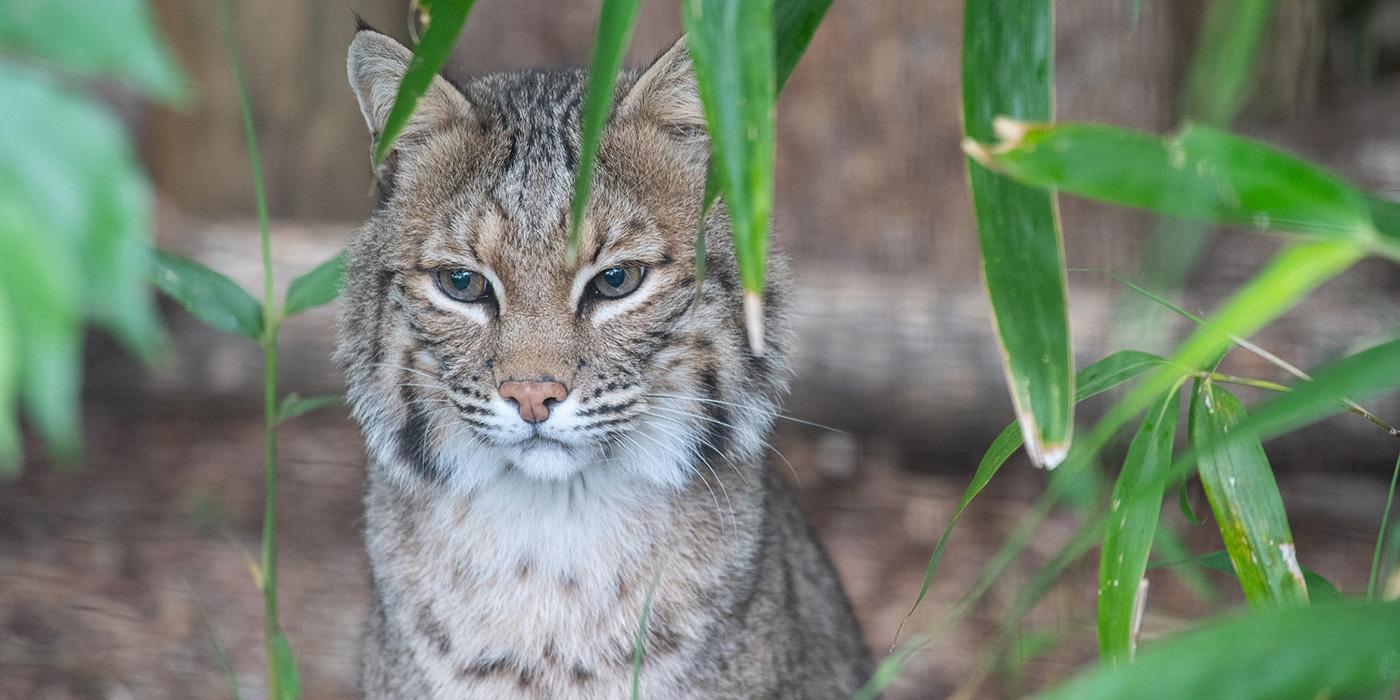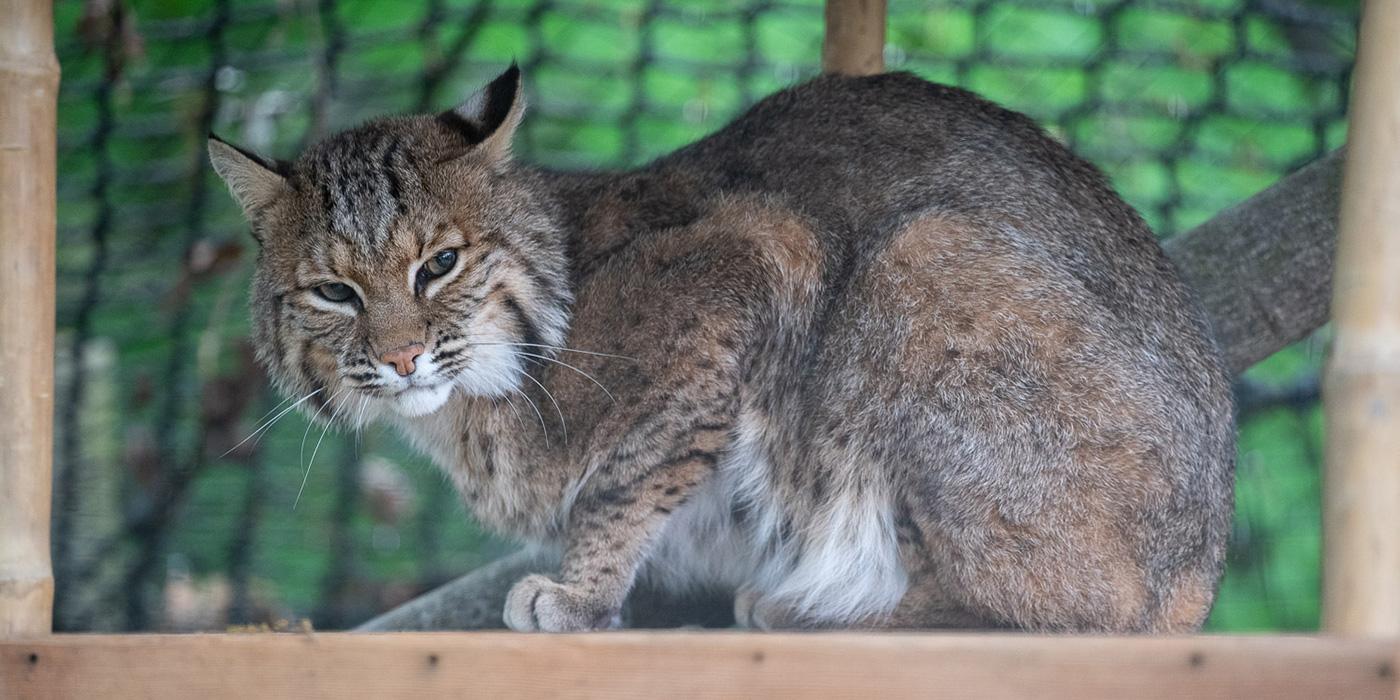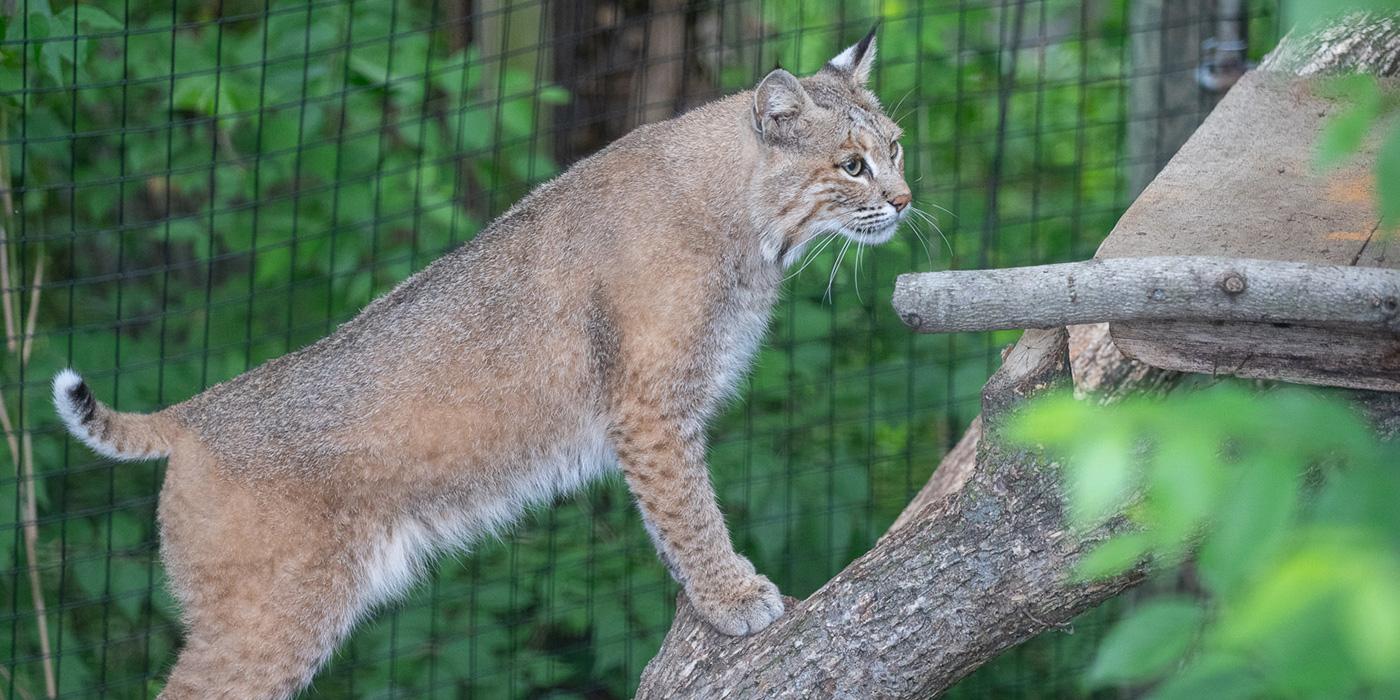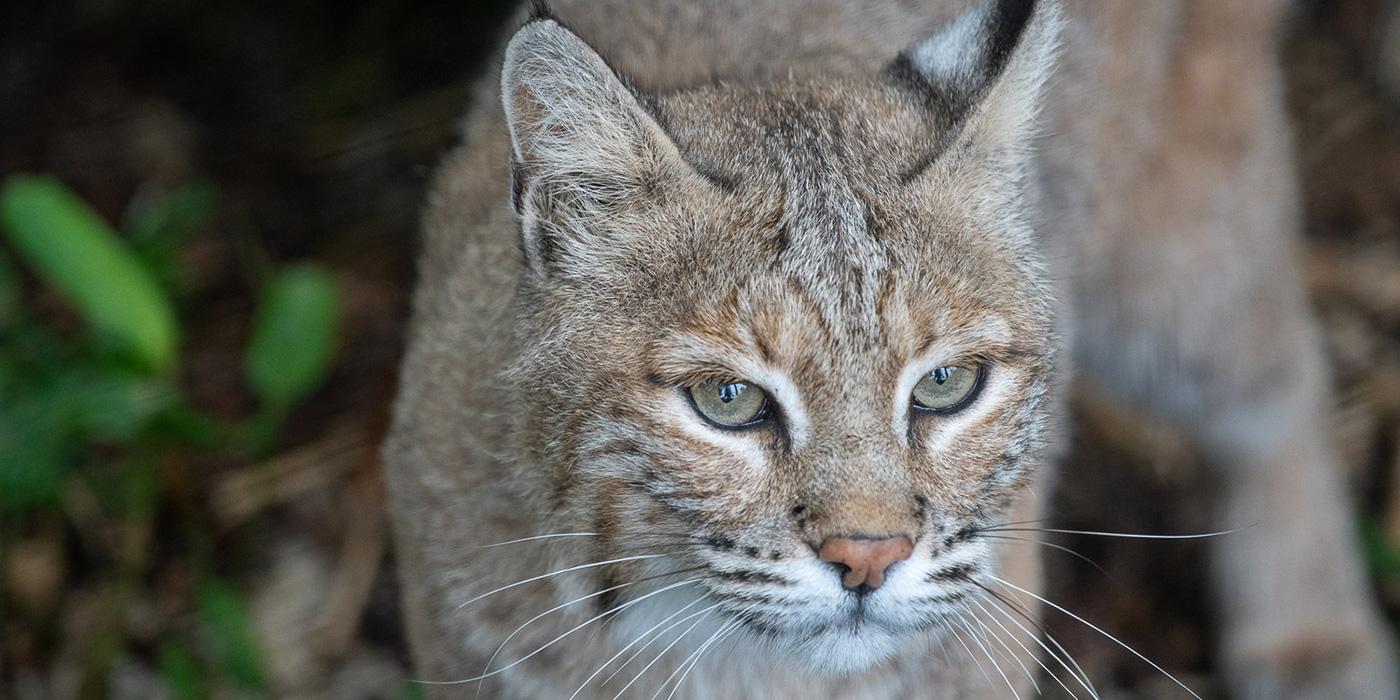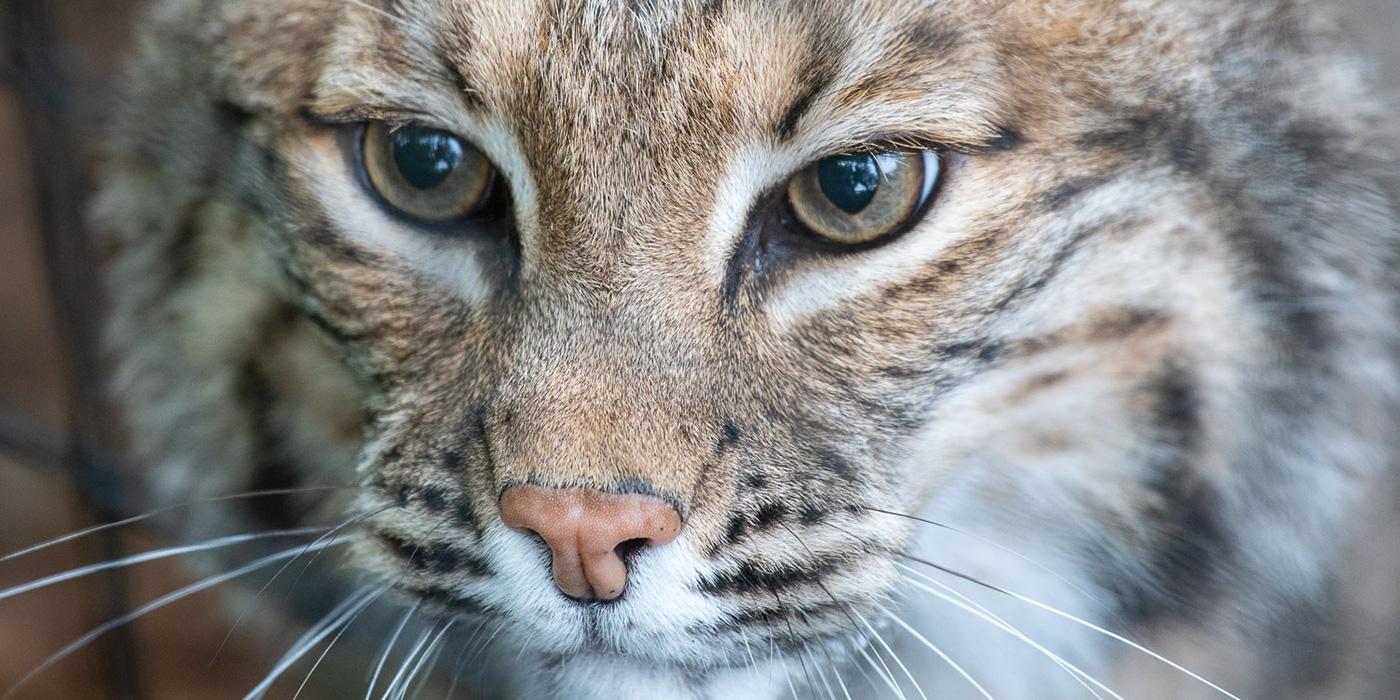Physical Description
The bobcat's fur is buff to brown, sometimes with a reddish tinge, and marked with spots or stripes of brown and black. The fur on its undersides is lighter in color. Bobcats have facial ruffs, ear tufts, white spots near the tips of their ears and bobbed tails.
Bobcats are often confused with the other three "lynx" species, the Canadian lynx, Iberian lynx and Eurasian lynx. Each lynx has characteristic facial ruffs and ear tufts, and a shorter tail than other cats. Bobcats are slightly smaller than other lynx and live in warmer climates at lower latitudes. The other lynx species occupy cold, northern latitudes where snow lies deep for much of the year and temperatures can reach lows of -70 degrees Fahrenheit (-57 degrees Celsius). Their footpads are well protected with a dense covering of fur, while the bobcat's footpads are bare. They also have shorter tails and longer legs for traveling through deep snow, where the bobcat is at a disadvantage.
The bobcat's black-spotted, brown coat blends in well with the rocks, brush and other dense vegetation where it hunts its main prey: the cottontail rabbit. Other lynx species have plain, brown-gray coats that provide camouflage in the mossy coniferous forests and swamps where they stalk their primary prey: the snowshoe hare. The dense cover where these lynx live may make sound more important than sight while hunting. Their ear tufts are thought to improve hearing and are longer than those of the bobcat.
The backs of a bobcat's ears are marked with two white spots, which a female's kittens probably follow in dim light. Another useful adaptation is the white underside of the bobcat's bobbed tail. If kittens fall too far behind their mother, the mother stops and softly calls to them while raising her tail to reveal the white patch below.
Size
Bobcats vary in size along their continental range, with larger animals found in the north and smaller animals in the south. They are generally 1.5-2 feet (46-64 centimeters) tall at the shoulder and weigh between 9 and 33 pounds (4 and 15 kilograms).
Native Habitat
The majority of the world's bobcats are found in the United States, but they range from Mexico to southern Canada. Bobcats are very adaptable and can live in a wide variety of habitats, including boreal coniferous and mixed forests in the north, bottomland hardwood forests and coastal swamps in the southeast, and desert and scrublands in the southwest.
Lifespan
Most bobcats live between five and 15 years in the wild. The median life expectancy of a bobcat in human care is about 18 years.
Communication
Bobcats communicate through scent, visual signals and vocalizations. The scent mark by urinating along travel routes, depositing feces in latrine sites and scraping urine and feces along trails. These marks can also indicate that a specific den is being used by a female and her kittens, signal that a female is receptive to mating, or delineate a home range.
They use body postures and facial expressions as close-range signals to warn off intruders. Bobcats rarely mew like domestic cats but will chortle and make birdlike chirps. During mating season, their vocalizations resemble that of a screaming domestic alley cat. North American bobcats primarily use scent marking and visual signals to mark their territory. They rarely use sound to deter other bobcats and instead rely on urine, feces and anal gland secretions, as well as marking scrapes in the ground.
Food/Eating Habits
Bobcats mostly eat rabbits and hares. They may also eat rodents, such as squirrels and mice, or hunt small deer, snakes, lizards and domestic animals, such as dogs, cats, sheep, goats and poultry. They can even leap high enough to catch low-flying birds.
Bobcats are excellent climbers and can run up to 30 miles per hour (48 kilometers per hour). They stalk their prey with unparalleled patience, and often travel 2 to 7 miles (3 to 11 kilometers) in an evening while hunting and patrolling their territory. They will place their back feet in the same spots where their front feet have stepped to reduce noise when hunting.
At the Zoo, bobcats eat a prepared meat diet, mice, rats, chicks and bones.
Sleep Habits
Bobcats may be active during all hours of the day and night, but studies have consistently found that they are crepuscular (most active at dawn and dusk).
Social Structure
Bobcats are solitary and territorial animals. The home range of a male bobcat overlaps that of several females, and males will mate with more than one female. Bobcats have a sophisticated form of land tenure and usually respect each other's territory. They mark their specific territories to minimize confrontations with other bobcats.
Reproduction and Development
The bobcat's mating season is primarily in the winter, though mating can take place from November through August. Gestation is about 60-70 days, with an average of 62 days, and there are usually two to four kittens per litter. Bobcats den in places protected from the weather, which can range from hollow trees and caves to spaces under dense shrubs or between boulders.
The female lines the den with moss and foliage, and the kittens are typically born in the spring. Once the kittens are born, the female drives the male away, but the male will stay in the area. The female nurses the kittens for two months. They travel with her for three to five months before separating from her for the winter mating season. Females are sexually mature and mate after one year, but males do not mate until they are 2 years old.
Conservation Efforts
Bobcats may be hunted for their pelts, but they face a greater threat from habitat loss. The Smithsonian's National Zoo participates in a bobcat Species Survival Program. Unlike other SSPs at the Zoo, the bobcat SSP does not manage an endangered species in human care (because bobcats are not threatened), but rather manages the placement of rescued and rehabilitated bobcats that cannot return to the wild.
Help this Species
Reduce, reuse and recycle — in that order! Cut back on single-use goods, and find creative ways to reuse products at the end of their life cycle. Choose recycling over trash when possible.
Share the story of this animal with others. Simply raising awareness about this species can contribute to its overall protection.
Meet the Animals
The Zoo’s three bobcats were born in the wild and ended up at a rehabilitation facility while young. Rehabilitators determined each cat did not have the skills needed to survive in the wild. The trio arrived at the Zoo from a sanctuary in Texas in Feb. 2013.
The bobcats are not endangered and are not part of a breeding program. Instead, they are educational ambassadors, living at the Zoo to help visitors connect with a native North American species.
Ollie is the only female bobcat. Professionals at the rehab facility estimate she was born between March and May 2010. Keepers at the Zoo celebrate her birthday on April 9.
Want to tell them apart? Ollie is the palest in coloration and has a round face. Her favorite snacks are mice.
Cheese is one of two male bobcats. Professionals at the rehab facility estimate he was born between Aug. and Oct. 2010. Keepers at the Zoo celebrate his birthday on Sept. 18.
He is very smell oriented and likes to roll around on scented objects, especially logs from nearby exhibits and tubs with spices sprinkled inside.
Want to tell them apart? Cheese has the darkest coat markings and spots on his nose.
Yoda is the second of two male bobcats. Professionals at the rehab facility estimated he was born between July and September of 2011. Keepers at the Zoo celebrate his birthday on Aug. 25.
He is very vocal and will often greet keepers with a “meow” before feeding time.
Want to tell them apart? Yoda has V-shaped markings above his eyes.
Smithsonian's National Zoo and Conservation Biology Institute. (n.d.). Bobcat. Retrieved October 22, 2025, from https://nationalzoo.si.edu/animals/bobcat
Animal News

7 Spooktacular Animal Facts for Halloween ›

Meet the Orangutans Living at the Smithsonian’s National Zoo ›

